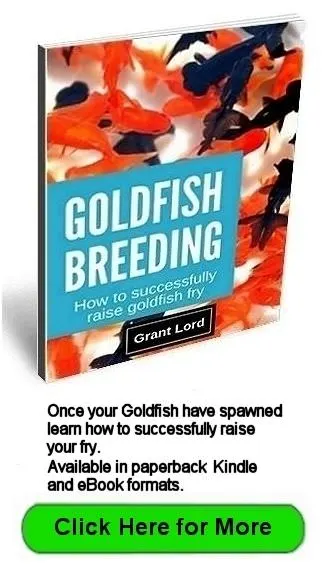Ranchu Goldfish Care, Feeding, Diseases, Breeding, and more...
Introduction
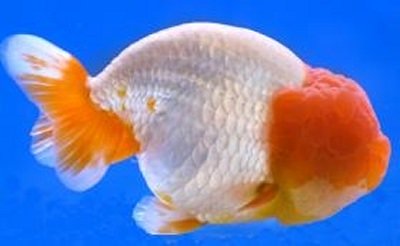 High quality Ranchu Goldfish
High quality Ranchu GoldfishThe Ranchu Goldfish is one of the most popular fancy varieties sold.
The Ranchu and Lionhead are often mentioned together in some publications as if they were the same Goldfish variety. They are not.
The Ranchu is a Japanese Goldfish variety; the Lionhead is Chinese.
Ranchu are highly prized in Japan, and champion fish command very high prices. Their curved backs, raspberry-like head wens, twin tails, and no dorsal fin produce many challenges for breeders trying to breed high-quality fish.
Last update: 16-03-2025 by Grant Lord
Ranchu Goldfish General Care Guidelines
Ranchu require no special care except for these important rules:
- As the image above shows, some wens can grow so large that they cover the eyes. If this happens, the wen should be trimmed, or the fish should be isolated or kept with other fish with similar sight limitations.
- Give them a varied diet, especially as they get older, to avoid swim bladder problems.
Ranchu Goldfish History and Origin
All Goldfish varieties can be traced back to the Prussian or Gibel carp. Through selective breeding of fish that developed odd genetic characteristics such as gold coloration and twin tails, all 100 plus different varieties have been created.
All Goldfish varieties have the same scientific name of Carassius auratus auratus var., not Carassius gibelio, which is interesting because no variety of Goldfish lives in the wild (unless introduced intentionally), not even the Common Goldfish.
The Ranchu Goldfish lineage can be traced back to the Maruko or Egg Fish, a fantail without a dorsal. The Egg Fish is directly linked to the twin-tailed Wakin, Japan's most popular Goldfish variety.
Physical Characteristics
Ranchu Lionhead Differences
The positions of the caudal peduncle and caudal fins of the Ranchu differ from those of a Lionhead Goldfish. These two features are what distinguish the two varieties.
The Ranchu back is more arched, with the caudal peduncle having a distinct downward tilt. The Lionhead's back is less curved, and the caudal peduncle is more square to the body.
The caudal fins of the Ranchu
are very spread, almost horizontal to the body. The caudal fins on the
Lionhead are less spread, looking more like most other twin caudal fin
varieties.
The hood on a Ranchu should cover three areas, and the amount of growth should be the same:
- The cap (the top of the head)
- The gill plates and
- The cheeks below the eyes.
Hood development in the Ranchu isn't as good as in the Lionhead.
What Should a Ranchu Goldfish Look Like?
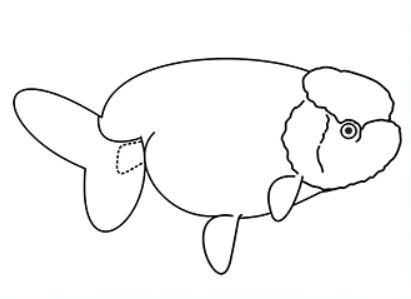 Ranchu side view UK standards
Ranchu side view UK standards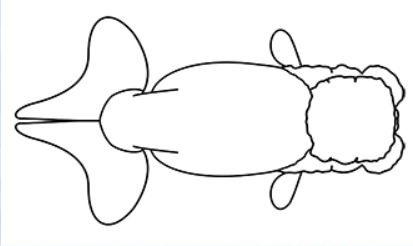 Ranchu top view UK standards
Ranchu top view UK standardsA good quality Ranchu has these characteristics:
- The body depth is 50% of the body length
- The wen or hood growth should be even across the head (cranial), cheeks, and gill plates (opercular)
- All fins are paired with the extremities slightly rounded. The tail fins should be divided and forked, even in size and shape, with no curled or bent extremities. They should be well spread and held above the horizontal.
The UK Nationwide Goldfish Standards also require a smooth arched back profile with no bumps, dips, or partial dorsal growths such as spikes or sails.
Genetics and early fry care dictate the body length a Ranchu and its hood development will achieve. 125mm (5 inches) body length is a good size for a Ranchu.
Scale Types of Ranchu Goldfish
Ranchu Goldfish are represented in the three main scale types: metallic, matt, and nacreous (calico).
The most popular type is metallic, as dramatic coloration can be achieved by contrasting the body color from the wen or head growth, as seen above.
The metallic scale type is one or two colors. Any black on a fish will be due to injury, or the fish will still be going through a color change.
Young metallic Ranchu under 30 days old are a drab grey, but depending on several factors such as water temperature, food, sunlight, and genetics, the young fish start to darken from around eight weeks. In strong sunlight, the juveniles will turn black, but inside, you may only see a slight darkening before it slowly fades into light gold, starting from the lower belly and moving up to the dorsal area.
When nacreous Ranchu are bred, all three scale groups are produced. Approximately half the fry will have nacreous scales, 25 percent will have matt scales, and the remaining 25 percent will be metallic.
The metallic specimens often take a long time to change color, if they do change color at all.
Feeding and Diet
 Repashy Super Gold Goldfish and Koi Gel food
Repashy Super Gold Goldfish and Koi Gel foodBeing deep-bodied, they will suffer digestive problems if fed low-quality food with not enough vegetable matter and live food included in the diet. This typically shows up as buoyancy problems with the fish bouncing on the surface with an intestine full of gas.
Gel foods are recommended as they mimic Goldfish's natural foods, which are mainly soft and moist.
Live foods can include mosquito larvae, daphnia, earthworms, blood worms, white worms, and adult brine shrimp.
If live food is hard to find or grow yourself, many specialist fish shops have the frozen equivalent.
I wouldn’t collect daphnia from the wild as parasites such as lice can be introduced into the aquarium.
Mosquito larvae are easy to raise, and Goldfish of all ages love them. Check whether you are legally allowed to raise them, as you can't in some countries and US states.
How much, how often, and what to feed your Goldfish depends on age, season, or whether you are conditioning your fish for breeding.
Because Goldfish only have rudimentary stomachs, they graze continuously, which is why they always appear hungry. Ideally, they should be fed 3 times a day, but for most, this is impracticable.
Adult fish should be fed between 1-2% of their body weight daily. If only one feeding a day is possible, a good quality food that won’t dissolve before the fish can eat it is needed. This is why a gel food such as Repashy Super Gold is recommended.
The danger of overfeeding is often the reason given to feed only what can be consumed in a few minutes.
Fact: Goldfish cannot be overfed! Goldfish are slow eaters compared to some fish species because they only have a rudimentary stomach. They force as much food as possible into their mouths and slowly chew and swallow it before looking for another mouthful.
During this period, dry, processed foods are dissolving. When the fish are looking for their second or third mouthful, the food has dissolved into dust that will decay and pollute the water.
Tank Setup and Maintenance
Suitable Tank Size for Ranchu
Ranchu are not one of the most active varieties, so one Ranchu needs 70 liters (15 gallons UK, 18 gallons US) with a filter installed.
70 liters is a good compromise between how big the fish will grow, how big the tank is to handle, water temperature swings, and the frequency of water changes needed to keep nitrates below 30 ppm.
For each additional Goldfish, another 45 liters (10 gallons UK, 12 gallons US) are required.
If your tank is for display purposes only, get a tank slightly taller than it is wide, as taller plants such as Vallisneria can be grown, and a taller tank has a larger viewing area.
Do not place your tank where it will receive direct sunlight or strong indirect sunlight. Even strong artificial light can be a problem. Tanks produce ideal algae growing conditions with their high nitrate levels; sufficient light is all that is necessary to produce an algal bloom.
If you have no option but to place your tank near a strong light source, you can always install a UV clarifier.
Maintaining Water Quality
Like all Goldfish varieties, the Ranchu requires good water quality to thrive. The difficulty with this is that Goldfish can become large given the right conditions; when young, they need a lot of food to grow quickly, which produces large amounts of waste.
The ideal water parameters for Ranchu are:
- PH between 6.5-7.4
- Nitrates below 30 ppm (parts per million). Very young fish (fry) require nitrates to be below 5 ppm.
- Ammonia needs to be at zero
- Nitrites need to be at zero
- Water temperature between 16-24oC (60-75oF)
- GH (general hardness) of 200 ppm or above (dGH 11)
- KH (carbonate hardness) of 143 ppm or above (dKH 8)
Most city water supplies fall into these parameters. If your water source is from a bore, it will pay to check the water parameters, as nitrates and hardness readings can often be very high.
Some water supplies can be extremely soft, with KH 0-1 and GH 2-3. If you want your fish to grow, the GH must be raised.
You will need a water test kit to check your water parameters regularly and determine when to make water changes. Get a test kit that has test tubes and solutions. Don’t use test strips, as they are notoriously inaccurate.
Making partial water changes without checking whether they are sufficient or often enough is just guessing.
Filtration and Heating
A filter, although not essential, does reduce the maintenance workload. Water changes must be made much more frequently to keep ammonia at a safe level if a filter is not installed.
Once it is cycled, a filter removes dangerous ammonia and nitrites, creating less harmful nitrates. A water change becomes necessary once the nitrate level goes above 30 ppm, which is why you need a water test kit.
Because Ranchu are not the strongest swimmers, a filter should turn the aquarium water volume over four times an hour but not create a current the fish have to swim against.
Ranchu are warm water fish, not cold water, not tropical, and prefer seasonal temperature changes.
Goldfish can take very low temperatures but only briefly, such as in Winter when they enter a dormant or low activity state. Low water temperatures like these are best tolerated by less developed varieties such as single-tailed Comets and Common Goldfish.
A heater is not required if kept indoors, where water temperatures will be well above freezing. If Ranchu are kept outside in a pond, and water temperatures are expected to fall below 7oC (45oF) for extended periods over Winter, bringing them inside for Winter would be wiser.
Fancy varieties of Goldfish often develop buoyancy problems if subjected to long periods of cold water temperatures.
Plants and Substrate
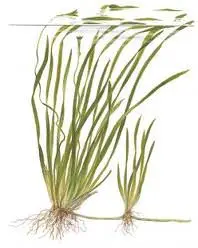 Vallisneria is a suitable plant for a Ranchu aquarium
Vallisneria is a suitable plant for a Ranchu aquariumGoldfish are omnivorous, meaning plant material forms part of their diet.
If you choose the wrong plants, your Ranchus will strip them to stalks within hours.
Suitable plants are;
- Vallisneria - used as a background plant because of the height it grows to
- Blue Hygrophila – used as a foreground plant. There is a dwarf variety available.
- Hygrophila Difformis – used as a foreground plant. Its fast growth helps control algae
- Red Bacopa – the leaves get a red tinge on the underside
- Ludwigia Arcuata – this plant requires a relatively large amount of light before forming a red stem and leaves.
Adding substrate or having a bare bottom tank is a personal choice, but there are some considerations before purchasing substrate;
- White substrate will cause your fish to lose color intensity
- Sand is not a good choice if you want to install an under-substrate filter. The grains need to be between 3 and 6mm in size.
- Goldfish will choke on small pieces of smooth gravel. I have lost two Black Moors from this.
- Are you planning on growing live plants? Plants can be grown in containers if you don't want to have substrate.
Aquarium Decorations
Aquarium decorations aren't such a problem for Ranchu as for other shortsighted varieties, such as Moors, who tend to blunder around an aquarium.
Having said that, if a Ranchu develops a very good wen (hood), the eyes are likely to be covered, and unless the wen is trimmed, the aquarium should be devoid of any sharp objects.
Decorations with holes or confined spaces should also be avoided as if it's possible to get stuck, Goldfish invariably will.
Suitable Tank Mates for Ranchu
The most common mistake novice Goldfish keepers make is to mix fancy varieties with single-tailed varieties. They don't realize that slow-swimming varieties such as Ranchu can't compete successfully with fast-swimming varieties for food.
What happens over time is as the single-tailed fish get the majority of the food, they get bigger and bigger, and the Ranchu doesn't thrive.
Ranchus can be kept with other Goldfish varieties, but a close watch needs to be kept on them to ensure they are thriving and getting their share of the food.
Plecos and Bristle Nose catfish used for removing algae can become a problem if they start eating the slime off the sides of your Ranchu as a protein supplement to their diet.
Any other small fish or aquatic life in the aquarium will be eaten if it can fit into your Ranchu's mouth.
Health and Diseases
Parasites
Several types of parasites attack Goldfish;
- Flukes if the body length of the fish is under 52mm (2 inches)
- Intestinal worms
- Protozoan parasites such as Costia and Ich (white spot)
- Free swimming aquatic parasitical crustaceans such as anchor worm and lice.
Bacterial Diseases
Bacterial infections can show as;
- Fin rot
- Bacterial gill disease
- Mouth rot
- Pop eye
- Raised scales
- Body sores (ulcers)
- Red patches on the body and fins
Fungal Infections
Fungal infections are quite common in Goldfish. They are usually seen as large or small tuffs of white cotton wool-like matter on the skin or fins.
A much more serious fungal infection is Branchiomyces, an aggressive fungus that kills fish by destroying gill tissue.
Viral Pathogens
The two most common viruses are:
- Lymhocystis virus, which appears as a white crusty growth on the skin and
- Papillomatous lesions caused by the cyprinid herpes or carp pox virus.
Both look very similar, but the treatment is different. Both are weakly transmissible, but neither is fatal.
More about Goldfish diseases here...
Quarantining New Fish
Quarantining new fish does not mean keeping them separated from your existing fish population for a few weeks and observing if they develop a disease.
It is unlikely fish being kept in pristine quarantine conditions and being fed high-quality food will succumb to any disease.
But what if the new fish carry a few parasites, such as flukes within the gills, and do not exhibit any symptoms?
And what if your fish have low immunity to flukes as they have never been exposed to them before?
It should be assumed your new Ranchu has parasites and should be treated for them.
A mild salt bath at the same time will take care of any bacterial or fungal infections that aren’t obvious at the time of quarantining.
An additional benefit of salt is that it boosts Goldfish's immune system.
Breeding Ranchu Goldfish
Male/female differences are less obvious outside the breeding season because of the short, round body shape. The female will often have a slimmer body shape than the male, giving the impression that she is a he.
The white tubercles that appear on the male’s operculum (gill plates) in the breeding season are not easily seen when covered by wen growth, so the tubercles on the leading edges of the pectoral fins will be the only indicators the male is in breeding condition.
The wen (hood) development should start to appear about 120 days after hatching. Maximum development can take four to five years, when large areas may be shed. Males produce better hoods than females.
Hood development is greatly affected by the way the fish is raised. Water quality, temperature, and diet all play a part. It is believed that water with algae hinders the hood's development.
Feeding large amounts of tubifex worms and bloodworms is also recommended, but finding enough supplies of these types of food is a problem for most.
Ranchu fry need to be viewed from the side in an aquarium as soon as dorsal fins start to show to allow fish developing them to be culled out. Back profiles can also be viewed for smoothness and contour.
More about breeding Goldfish here...
Summary and Key Facts
Country of Origin: Japan
Chinese Name: N/A
Japanese Name: Ranchu
Maximum size (body length): 125mm (5 inches)
Body Type: Deep and rounded, depth to be more than half the body length
Caudal Fin: Paired, divided, and forked, well spread and held above the horizontal
Dorsal Fin: Absent
Anal Fin: Paired
Scale Type: Represented in all three scale types
Eyes: Normal
Distinguishing traits: Deep-bodied, with an arched back and a wen (hood)
Special requirements: Not to be kept with single-tailed Goldfish unless a feeding regime is employed to ensure the Ranchu gets its share of the food.

